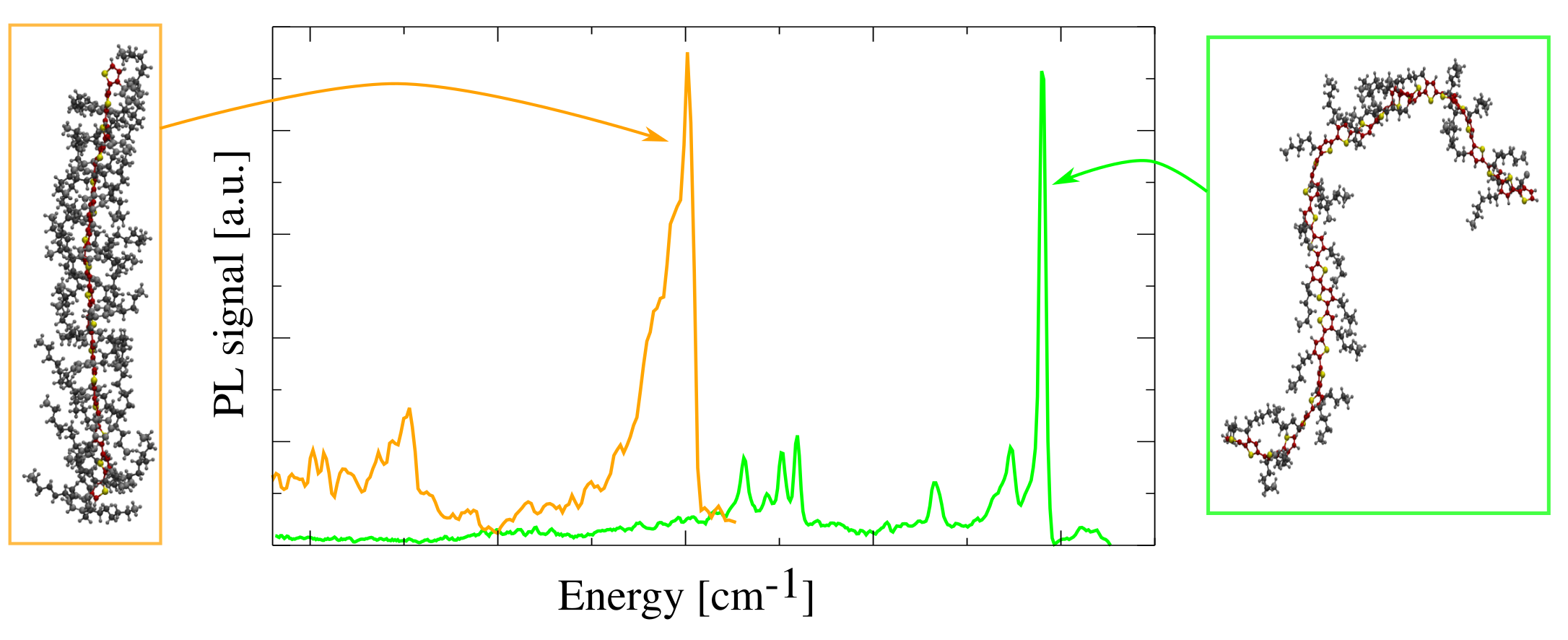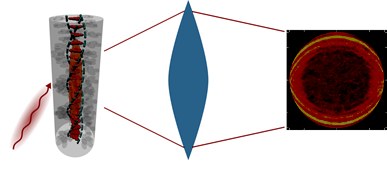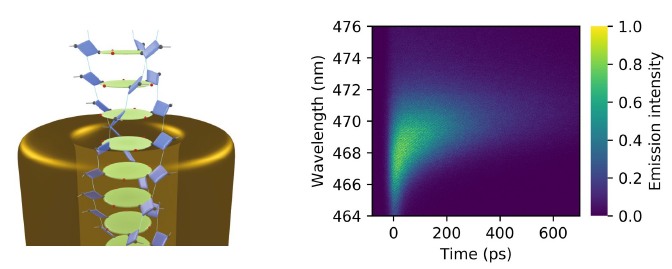Student projects
Our group, Optical Spectroscopy of Fuctional Nanomaterials, offers student projects on an ongoing basis. Below, you find suggestions for projects that are in line with our current research, and are suitable as Master or Bachelor projects.
Feel free to contact Prof. Richard Hildner to discuss all options!
>>> Some of these projects can entirely be done from home, if desired to do so. For those, no lab access is needed.
Master/Bachelor research projects
Single-Molecule Spectroscopy on Conjugated Copolymers for Solar Cells
Master research project (Spring 2021)
The idea:
Organic solar cells (OSC) based on low-bandgap copolymers, the second generation of conjugated polymers, recently achieved efficiencies > 17 %. The key advantage of such low-bandgap copolymers for OSCs is that upon light absorption the electron density is strongly displaced and a so-called chargetransfer excitation on a single chain is geneated. This charge-transfer state is then rather easily separated into free charge carriers, enabling a high OSC efficiency.
However, copolymers are, as any polymer, highly disordered. Thus, the correlation between chain conformation (geometric structure) and the spectroscopic properties (position and shape of optical spectra) are not well understood so far. In this project you will perform optical spectroscopy on single copolymer chains, looking at one chain at a time, at low temperature (4 K) to establish structurefunction relationships. A short introduction into this topic can be found in Francken Vrij, 23.3, pp. 28.

Your contribution:
- You perform low-temperature single-molecule photoluminescence spectroscopy on different lowbandgap copolymers provided by our chemistry collaborators (Chiechi-group);
- You cooperate with theory (R. Havenith) to establish relationships between the chain conformation and optical properties;
- You operate state-of-the-art equipment for optical (single-molecule) spectroscopy.
Prof. Dr. Richard Hildner
Office: 5117.0011
r.m.hildner@rug.nl
+31 50 36 38149
Simulation of Fourier Microscopy of Supramolecular Nanostructures
Master / Bachelor research project (2020)
>>> Can entirely be done from home, if desired to do so.
Our idea:
Our group focuses on single objects, from the single molecule to aggregates of such molecules. Recently, it has been found that such structures can be used for efficient energy transport. Our goal is to observe and understand this transport using optical microscopy and spectroscopy. In this project we would like to run simulations of the Fourier image collected from the radiation emitted by nanofibres, study the influence of different parameters on the energy transport, and finally predict experimental results.

Your contribution:
- Finalize code to calculate Fourier images of ensembles of radiating dipoles with MATLAB/Octave
- Compare different models for supra-molecular structures and energy transfer
- Study the influence of structure, exciton delocalisation, and disorder on Fourier images
- Develop fitting algorithms to compare simulations with data
Contact us :
If you want to learn more and get to know us:
Prof. dr. Richard Hildner, Office: 5117.0011, Email: r.m.hildner rug.nl, Tel: +31 50 36 38149
Ioannis Touloupas, Office 5117.0006, Email: i.touloupas rug.nl, Tel: +31 50 36 32416
Characterization of a Joule heating stage for in-situ spectroscopy
Master / Bacholor research project (Spring 2020)
Our idea:
Controlled self-assembly (or crystallization) of organic molecules can significantly improve their optical and electronic properties, and is a crucial aspect for the fabrication of optoelectronic devices. To analyze the (re-) crystallization of organic materials, we designed a heating stage based on Joule heating of a transparent indium-tin-oxide (ITO) film, which readily integrates into a confocal spectroscopy setup. In this project, you will characterize the properties of the heating stage, such as temperature-stability, temperature-uniformity, and degradation over several heating cycles.

Your contribution:
- Characterize the properties of a home-made Joule heating stage for microscopy
- Optimize heating/measurement protocols for repeatability and stability
- Perform temperature-dependent reference measurements on organic nanostructures
- Operate state-of-the-art equipment for spatially- and time-resolved spectroscopy
Contact us :
If you want to learn more and get to know us:
Prof. dr. Richard Hildner, Office: 5117.0011, Email: r.m.hildner rug.nl, Tel: +31 50 36 38149
Sebastian Stäter, Office: 5117.0006, Email: sebastian.staeter rug.nl, Tel: +31 50 36 32416
Ioannis Touloupas, Office 5117.0006, Email: i.touloupas rug.nl, Tel: +31 50 36 32416
Full text as PDF
Time-Resolved Emission Spectroscopy on Self-Assembled Nanostructures
Master / Bacholor research project (Spring 2020)
Our idea:
Self-assembly of organic molecules into supramolecular nanostructures often results in different species of aggregates with slightly different molecular arrangement. The photophysical properties of such species often differ in the spectral and the temporal domain. In this project, you will use an interferometer-based approach to discriminate between different species of aggregates, analyze their photophysical properties, and reveal details about intermolecular order.

Your contribution:
- Operate state-of-the-art equipment for spatially- and time-resolved spectroscopy
- Optimise a setup for fluorescence excitation spectroscopy and quantify its sensitivity
- Perform experiments on crystalline nanofibrillar structures
- Analyse spectroscopic data to correlate absorption and fluorescence excitation spectra
Contact us :
If you want to learn more and get to know us:
Prof. dr. Richard Hildner, Office: 5117.0011, Email: r.m.hildner rug.nl, Tel: +31 50 36 38149
Sebastian Stäter, Office: 5117.0006, Email: sebastian.staeter rug.nl, Tel: +31 50 36 32416
Ioannis Touloupas, Office 5117.0006, Email: i.touloupas rug.nl, Tel: +31 50 36 32416
Full text as PDF
Self-Assembly of Organic Nanofibers
Master / Bacholor research project (Spring 2020)
Our idea:
Organic self-assembled nanofibers enable long-range transport of excitation energy, and are building blocks for new nanophotonic devices. Nanofiber growth in solution depends on a variety of parameters, and good control over the growth process is crucial to tune the optical properties. In this project, you will investigate the influence of heating profiles and centrifugation on the yield of organic nanofibers. You will also employ a variety of microscopic and spectroscopic techniques.

Your contribution:
- Develop specific heating curves to optimize nanofiber growth in solution
- Employ centrifugation to improve nanofiber yield & quality
- Analyze nanofiber solutions with a variety of spectroscopic techniques
- Operate state-of-the-art equipment for spatially- and time-resolved spectroscopy
Contact us :
If you want to learn more and get to know us:
Prof. dr. Richard Hildner, Office: 5117.0011, Email: r.m.hildner rug.nl, Tel: +31 50 36 38149
Sebastian Stäter, Office: 5117.0006, Email: sebastian.staeter rug.nl, Tel: +31 50 36 32416
Ioannis Touloupas, Office 5117.0006, Email: i.touloupas rug.nl, Tel: +31 50 36 32416
Full text as PDF
